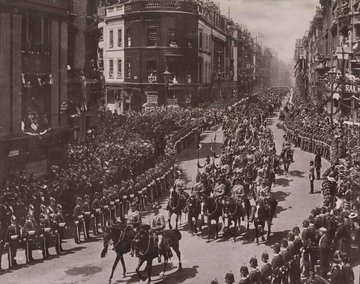
Queen Victoria's Diamond Jubilee
Place of event
London and other cities in the British empire
About
Queen Victoria’s Diamond Jubilee of 1897 was both a more restrained and a far grander celebration of her reign than the Golden Jubilee of the previous decade. The Queen’s own involvement was greatly diminished on account of her increasing frailty. As an example of alterations in ceremony, the thanksgiving service took place not in Westminster Cathedral but in the open, outside St Paul’s Cathedral, so that the Queen could remain in her carriage. The scope of the celebrations, however, expanded considerably for the Diamond Jubilee, with a celebration of empire becoming arguably the central theme: ‘unlike the Golden Jubilee, which had placed Victoria and her family at the centre of the festivities, the Diamond Jubilee would focus almost exclusively on a celebration of the British Empire’ (King, p. 19). Joseph Chamberlain is generally credited for this shift in focus.
Before leaving Buckingham Palace on 22 June, the Queen issued a telegraph throughout the empire, saying, ‘From my heart I thank my beloved people. May God bless them!’ Invitations had been issued to all the Indian princes, but many were forced to remain at home to deal with the aftermath of the devastating famine of 1896–7. Many Indian troops, however, participated in the processions through London, including Bengal lancers, officers of the Indian Imperial Service Troops in kirtas with gold sashes, and Sikhs marching alongside Canadians. The Daily Mail wrote: ‘Up they came, more and more, new types, new realms at every couple of yards, an anthropological museum – a living gazetteer of the British Empire’ (23 June 1897).
Upon her return to Windsor on 23 June, the Queen was met by four young Indian students from Eton College: ‘sons of the Maharajahs of Kuch, Behar, the Minister of Hydrebad, and the Prince of Gondal’ (King, p. 268). On 2 July the Queen surveyed the colonial troops at Windsor. A court circular erroneously claimed she had addressed the Indians in Hindustani, which was allowed to pass by the Queen, who said, ‘I could have done so had I wished’ (Ponsonby, pp. 62–3; quoted in King, p. 269).
Celebrations were also held throughout India. Typically, responses focused on the unifying effect of Queen Victoria and presented her in a maternal light.
British Government
Joseph Chamberlain (Colonial Secretary), community leaders throughout Britain and India.
Buckle, George Earle (ed.) The Letters of Queen Victoria: A Selection from Her Majesty’s Correspondence and Journal between the Years 1886 and 1901, 3 vols (London: John Murray, 1930–2)
Chapman, Caroline and Raban, Paul (eds) Debrett’s Queen Victoria’s Jubilees 1887 and 1897, foreword by H. B. Brooks-Baker (London: Debrett’s Peerage, 1977)
Hibbert, Christopher, Queen Victoria: A Personal History (London: HarperCollins, 2000)
King, Greg, Twilight of Splendour: The Court of Queen Victoria during Her Diamond Jubilee Year (Hoboken, NJ: John Wiley & Sons, 2007)
Longford, Elizabeth, Queen Victoria (London: Weidenfeld & Nicolson, 1964)
Ponsonby, Sir Frederick, Recollections of Three Reigns (New York: E. P. Dutton, 1952)
Visram, Rozina, Asians in Britain: 400 Years of history (London: Pluto Press, 2002)
Newspapers from Britain and South Asia, British Library Newspapers, St Pancras
National Archives of India, New Delhi
Letters, journals, and other papers, Royal Archives, Windsor Castle, Windsor
Image credit
Queen Victoria's Diamond Jubilee Procession – The Colonial Contingent, by London Stereoscopic & Photographic Company, vintage print, 22 June 1897, NPG P1700(25a)
© National Portrait Gallery, London, http://creativecommons.org/licenses/by-nc-nd/3.0/
